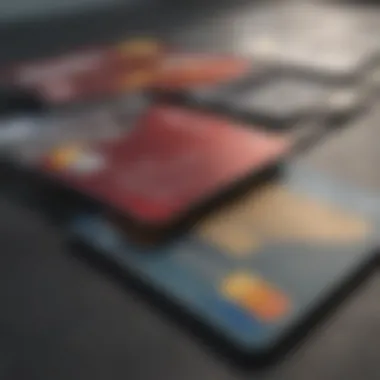Top Bad Credit Cards: A Detailed Overview


Intro
Navigating the world of credit can feel like walking a tightrope, especially for those wrestling with poor credit ratings. This is where bad credit cards come into play. They're often seen as the lifeboat for individuals looking to stay afloat in financial choppy waters. But while they offer a lifeline, they come with their own set of challenges that demand careful consideration.
In this guide, we will take a closer look at various aspects of bad credit cards, all while keeping in mind the needs of young professionals, students, and small business owners. We wish to arm you with knowledge about the types of cards available, the fees they're likely to incur, and the potential pitfalls to watch out for. Equipped with this kind of information, you'll be better positioned to make informed choices and steer your financial ship in the right direction.
With a keen focus on empowering financial literacy, we will uncover the nuances of credit management and explore ways to improve your creditworthiness over time. Understanding these concepts becomes increasingly important for anyone climbing the financial ladder, even if it's just one rung at a time. A foundational grasp of these financial principles can also set the stage for smarter budgeting and investment strategies moving forward.
So, let’s dive into the ocean of financial knowledge, exploring the depths and occasional murky waters of bad credit cards. It’s time to illuminate the dark corners of this topic and help you navigate your financial journey with confidence.
Understanding Bad Credit Cards
Navigating the landscape of bad credit cards requires a keen understanding of what they are and why they exist. This article's focus on understanding bad credit cards serves an important purpose, especially for young professionals and small business owners who may find themselves in a tight spot financially. Grasping the nuances of these cards and their implications can help you make more informed financial decisions.
Defining Bad Credit
Before jumpin’ into the nitty-gritty, let’s define what bad credit actually means. Simply put, bad credit refers to a low credit score, typically below 580, which can limit your access to favorable financial products. This score is derived from various factors, including payment history, credit utilization, and the length of your credit history. When someone has bad credit, it often leads to committing a proverbial sin: borrowing struggles.
Not only does it make obtaining loans difficult, but it can also result in higher interest rates on credit products, which, in turn, compounds the existing financial woes.
Additionally, it’s essential to recognize that bad credit isn’t a death sentence. There are many individuals, like recent graduates or small business owners, who may fall into this category due to student loans or initial venture failures. The key is understanding how to navigate the situation and improve one’s standing over time.
Why Bad Credit Cards Exist
The existence of bad credit cards can be seen as both a necessity and a consequence. From one perspective, these financial products cater to a specific segment of the population: individuals who cannot qualify for traditional credit cards. These cards often come with higher fees and interest rates to compensate for the risk lenders take on when approving those with poor credit histories.
On the other hand, they help to provide an opportunity for individuals to establish or rebuild their credit over time, acting like a double-edged sword. For example, a student juggling tuition and rent might find a bad credit card to be a viable option to cover unexpected expenses.
"Bad credit cards can offer a lifeline for those struggling, but they require careful management to ensure they don’t sink deeper into financial troubles."
In this sense, bad credit cards serve a dual purpose: they fulfill a market need while simultaneously challenging users to practice good financial habits. But, it’s vital for potential users to weigh their options carefully—making sure they fully understand the terms, conditions, and fees associated with these cards to avoid being caught in a debt trap.
Now that we've set the stage, the next parts will delve deeper into the credit scores and their larger implications, ensuring you have all the tools necessary to make smart financial choices.
The Importance of Credit Scores
Credit scores play a pivotal role in a person's financial health. They are the unspoken language that dictates the terms of lending, affecting everything from interest rates to insurance premiums. For those navigating the realm of bad credit cards, understanding the implications of credit scores is vital. Poor scores can reflect missed payments, high credit utilization, or erroneous entries. It's not just numbers on a report; these scores are indicators of trustworthiness, serving as a key factor in determining whether someone can secure a loan, rent an apartment, or even land a job in some sectors.
Most creditors gauge their risk exposure before extending credit. Higher scores often translate into lower interest rates and more favorable terms. Conversely, if you're operating with a shaky or subpar score, lenders are often more wary, which leads to higher costs in the form of fees and higher interest rates. This section dives into the essence of credit scores, breaking down the factors that contribute to their calculation and their profound impact on financial choices.
What Influences Your Credit Score
A variety of elements combine to shape your credit score. Here are the primary factors:
- Payment History: This is often the heaviest weighting in the score calculation. A consistent record of on-time payments can greatly enhance your score.
- Credit Utilization Ratio: This figure represents the amount of credit you're using compared to your total available credit. A lower ratio often reflects better management of credit.
- Length of Credit History: This pertains to how long your accounts have been active. A longer history generally works in your favor, showcasing reliability.
- Types of Credit: Having a mix of credit types—like installment loans and revolving credit—can favorably influence your score.
- Recent Inquiries: When lenders check your credit report for lending purposes, it can result in a hard inquiry. Numerous hard inquiries can indicate risk.
Maintaining awareness of these elements helps individuals shape their credit habits. For instance, if you're nearing maxing out credit cards frequently, it could be wise to adjust spending habits before applying for a new card. Staying informed can sidestep pitfalls and open up more financial avenues.
How Bad Credit Affects Financial Options
The ramifications of bad credit extend well beyond just obtaining a loan; they permeate various aspects of one’s financial landscape. Individuals grappling with low credit scores may encounter:
- Higher Loan Costs: Bad credit often means lenders charge an elevated interest rate to offset risk, which can make borrowing far less affordable.
- Limited Access to Credit: Many lenders may decline applications altogether or offer only cards with unfavorable terms, locking individuals into a cycle of debt.
- Increased Security Deposits: When renting, landlords might demand larger security deposits as insurance against the risk of non-payment.
- Insurance Premiums: Insurance companies often use credit scores as part of their formula for determining premiums, meaning those with worse scores could face increased costs.
Bad credit can feel like a heavy anchor, limiting financial freedom and opportunities.
In essence, bad credit doesn’t just represent a number; it comes with tangible consequences that can impact both immediate needs and long-term goals. Understanding these implications can enlighten individuals to take charge of their financial destinies, ideally prompting actions that lead to score improvement and better opportunities down the line.
Key Features of Bad Credit Cards
When it comes to navigating the world of bad credit cards, understanding their key features is crucial. Many individuals may find themselves needing a credit card despite having less-than-stellar credit. These cards can serve as a lifeline, allowing users to build or rebuild their credit. However, they come with unique characteristics that one must be fully aware of. Knowing these features can make the difference between a wise financial decision and a costly mistake.
High Interest Rates
One of the most defining characteristics of bad credit cards is their high interest rates. When your credit score is on the lower end of the spectrum, lenders see you as a higher risk, which translates into exorbitant rates. It's not uncommon to encounter annual percentage rates (APRs) soaring above 25%. This means that, if you're not careful, you can quickly find yourself in a cycle of debt that becomes harder to escape.


"If you really have to use a bad credit card, treat it like a double-edged sword. It can help you but can cut deep if you're not paying attention."
Why This Matters: High interest rates mean that any balances carried month-to-month will increase significantly. Therefore, if you plan to use a bad credit card, it’s wise to pay off the balance each month to avoid accruing interest. For example, if you had a small balance of $500, at an APR of 24%, you might pay $120 in interest over a year just for carrying that balance.
Monthly and Annual Fees
Bad credit card issuers often charge various fees that can add up quickly. These include both monthly maintenance fees and annual fees. A monthly fee might seem small—around $5 to $10—but it can accumulate over time, particularly if you hold the card for an extended period.
On the flip side, many cards come with hefty annual fees ranging from $30 to even $100. This can be a frustration for consumers who are seeking a fresh start. The fees are essentially the price of doing business with a lender willing to extend credit to someone with bad credit.
Consideration: Always read the fine print. It’s imperative to understand what fees apply, and when they will be charged. Knowing this upfront can help you better manage your financial strategy and avoid unwanted surprises.
Low or No Credit Limits
Lastly, many bad credit cards feature low or nonexistent credit limits. This is often a reflection of the card issuer's cautious approach to high-risk customers. A predictably low credit limit may give you just enough wiggle room to cover essential purchases, but you'll want to use it prudently. Low limits mean there's a risk of maxing out your card quickly, which can adversely affect your credit utilization ratio.
Effect on Credit Score: Ideally, you want to keep your credit utilization below 30% of your available credit. For example, if your limit is only $300, try to keep your balance under $90. This will indicate to other lenders that you are capable of responsible credit use, which may help you get better options in the future.
In summary, the key features of bad credit cards shape the way users interact with credit. High interest rates, various fees, and low credit limits all play into the unique landscape that surrounds bad credit cards. By being well-informed, individuals can make choices that serve their long-term financial health.
Assessing the Top Bad Credit Cards
Assessing the top bad credit cards is a critical step for anyone looking to improve their financial standing despite having a less-than-stellar credit history. Bad credit cards often come with various features and limitations. Understanding what to look for can help individuals make well-informed choices.
Why is Assessment Important?
Bad credit cards can either trap you further into debt or serve as a stepping stone to restoring your credit score. If you don’t know what you’re signing up for, you might end up with sky-high interest payments or oppressive fees that bite into your finances month after month. By assessing the available options, one can pinpoint cards that offer feasible terms and potential rewards, all while minimizing unnecessary costs.
Overview of the Market
Looking at the current landscape, the bad credit card market welcomes a certain degree of diversity. This isn't just a niche filled with one-size-fits-all options. Instead, there's a patchwork of offers tailored to various needs, from those just starting to rebuild to those needing to keep their spending in check until their credit improves.
Many individuals find themselves in the bad credit category due to mishaps, be it medical expenses, job loss, or impetuous financial decisions. Card issuers recognize this and concoct schemes designed to attract customers desperate to regain control.
Such competition aids consumers pretty well. Potential options include cards with lower fees, manageable interest rates, and perks like rewards programs designed to encourage responsible use. It’s not all doom and gloom if you know where to peek.
Criteria for Selection
Not every card is created equal, and knowing which criteria to apply while selecting will enable users to sift through the clutter effectively. Here are some key considerations:
- Interest Rates: Look for cards with manageable rates. High interest can lead to a spiraling debt cycle. If the rate is too steep, hold off.
- Fees: Monthly fees, annual fees, and transaction fees can take a big bite out of any benefits you might get from the card. Ensure you factor in all fees to get a realistic view.
- Credit Limits: Many bad credit cards might come with low credit limits. Determine whether this suits your spending habits and needs.
- Reporting to Credit Bureaus: Make sure the card issuer reports to all three major bureaus. This can make or break your ability to improve your credit score over time.
- Additional Benefits: Some cards offer perks like cashback or rewards for responsible usage. These can be beneficial, provided the associated costs are not prohibitive.
In summary, assessing the right bad credit cards involves recognizing what distinguishes the good from the bad in terms of fees, limits, and opportunities for rebuilding credit. Each individual’s financial situation is unique; hence, it’s crucial to evaluate options through that lens. As the saying goes, "Don’t put all your eggs in one basket"—diversifying your approach to credit is no different.
"You don’t build a reputation on what you’re going to do." —Henry Ford
Armed with the knowledge of the marketplace and a clear selection criteria, individuals can better navigate their choices, paving the way for improved credit and ultimately a more sound financial future.
Detailed Review of Selected Bad Credit Cards
In this section, we explore the finer points of selected bad credit cards that one might consider when diving into the challenging world of credit. For many individuals with poor credit, these cards can serve as a stepping stone back to financial stability, despite often coming with high costs and constraints. The aim here is to dissect each card’s features and fees candidly, so potential cardholders can make sound choices that align with their financial aspirations.
Card One: Features and Fees
Card Name: The Secured Mastercard
The Secured Mastercard is a well-known option for individuals looking to rebuild their credit score. Its most significant feature is the mandatory security deposit, which typically ranges from a few hundred to a couple thousand dollars. This deposit functions as the credit limit.
Fees:
- Annual Fee: $39
- Foreign Transaction Fee: 3%
This card allows you to earn rewards on purchases, which is quite rare for secured cards. It reports to all three major credit bureaus, helping users to boost their credit scores with responsible usage.
Card Two: Features and Fees
Card Name: Total Visa® Card
This card is geared toward those with less-than-stellar credit. It's a good option for rebuilding credit history as it reports to the major credit bureaus regularly. The Total Visa® is unsecured, meaning no deposit is required, which is an advantage for many.
Fees:
- Annual Fee: $75 first year, $48 after that
- Monthly Maintenance Fee: $6.25
- Late Payment Fee: Up to $38
Be aware that the high fees associated can quickly eat into your financial flexibility, so it’s essential to stay on top of payments.
Card Three: Features and Fees
Card Name: Credit One Bank® Platinum Visa®
This card comes with several perks like cashback rewards on eligible purchases, something unusual for cards designed for those with poor credit history. Users can see where their credit stands with a free credit score access feature.
Fees:
- Annual Fee: $0 to $99 depending on the creditworthiness
- Cash Advance Fee: 5%
- Late Payment Fee: Up to $39
While the potential for rewards is attractive, those with bad credit should weigh the annual fees against the rewards to make sure it’s financially sensible.


Card Four: Features and Fees
Card Name: Indigo® Platinum Mastercard®
The Indigo® Platinum Mastercard® prides itself on being accessible for those with poor credit. It often offers pre-qualification without a hard inquiry, making it easier on your credit score if you’re still building it.
Fees:
- Annual Fee: $0 to $99, depending on creditworthiness
- Foreign Transaction Fee: 0%
It also allows you to manage your account online, a feature that's becoming increasingly essential for busy individuals.
Card Five: Features and Fees
Card Name: OpenSky® Secured Visa® Credit Card
The OpenSky® card doesn’t perform credit checks, making it a good choice for people aiming to avoid the credit scrutiny hurdles that many cards require. Also, it has a very basic fee structure.
Fees:
- Annual Fee: $35
- No late fees if you pay the total amount due by the due date
This card emphasizes simplicity, so if straightforward terms are what you're after, this'd be a sensible consideration.
Card Six: Features and Fees
Card Name: Milestone® Gold Mastercard®
This option offers a chance for those with less-than-ideal credit histories. Pre-qualification is an option with this card, which can help avoid hard inquiries on your credit profile when you apply.
Fees:
- Annual Fee: $35 to $99
- Late Payment Fee: Up to $39
It is relatively easy to get approved for but be careful with the fees that can build up.
Card Seven: Features and Fees
Card Name: Legacy Visa® Secured Credit Card
The Legacy Visa® is another secured card option designed to help users improve their credit scores. It features a straightforward deposit requirement equivalent to your credit line.
Fees:
- Annual Fee: $75
- Activation Fee: $89
While structured to assist in establishing a credit history, this activation fee can be a deterrent for some.
Card Eight: Features and Fees
Card Name: American Express® Green Card
Although more commonly associated with higher credit ratings, some versions of the Green Card may be accessible to individuals working to improve their credit. This card does include certain perks but may require a hefty annual fee.
Fees:
- Annual Fee: $150
- Cash Advance Fee: 5%
The cost for this card can add up quickly, and it might be more suited for someone who can afford to pay off balances regularly.
Card Nine: Features and Fees
Card Name: Discover it® Secured Credit Card
Known for its rewards structure even for secured cards, the Discover it® card helps customers not only stabilize but also grow their finances.
Fees:
- Annual Fee: $0
- Cash Advance Fee: 5%
Provides cashback on certain spends, which is great for those seeking to optimize their returns as they rebuild credit.
Card Ten: Features and Fees
Card Name: Wells Fargo Secured Credit Card
Lastly, the Wells Fargo option is yet another secured credit card but offers a lower deposit limit for those who may not have much to put down.
Fees:
- Annual Fee: $25
- Foreign Transaction Fee: 3%
Offers the comfort of a reputable bank brand, yet it still requires careful management to avoid limitations in growth.
Each card outlined above serves a unique purpose and comes with its advantages and disadvantages. Weighing these carefully can significantly impact your financial trajectory and credit rebuilding efforts.
Weighing the Pros and Cons
In the world of personal finance, understanding the nuances of bad credit cards is essential. For many, these financial tools serve as a double-edged sword. While they provide an avenue for rebuilding credit, they can also lead one down a treacherous path if used without caution. Weighing the pros and cons becomes a critical exercise, helping individuals discern the practical benefits alongside potential pitfalls.
By doing this, young professionals, students, and small business owners can make informed financial decisions that align with their long-term goals. Bad credit cards can be a stepping stone towards better financial health if navigated wisely, allowing cardholders to regain control over their credit scores. However, they can also be a source of added financial strain if one does not tread carefully.
Advantages of Bad Credit Cards
- Opportunity for Credit Building: Perhaps the most significant advantage accruing to bad credit card holders is the chance to rebuild their credit scores. Using these cards responsibly—by making timely payments and keeping balances low—can slowly improve credit ratings over time.
- Access to Credit: Individuals with a poor credit history often find themselves boxed out of many financial products. Bad credit cards can serve as a lifeline, granting access to credit when it seems impossible elsewhere.
- Flexible Spending: While limits may be low, these cards allow for some degree of flexibility in spending. For instance, individuals can utilize these cards for unexpected expenses, thus preventing further damage to their credit by not defaulting on other obligations.
- Rewards Programs: Some bad credit cards do offer rewards, albeit limited. Though not prevalent, perks like cash back on purchases can still provide some value, especially when spending is strategically aligned with earning rewards.
- Building Financial Habits: Bad credit cards can also encourage better financial management. The act of making monthly payments can foster discipline, teaching users the importance of budgeting and tracking spending closely.
Drawbacks to Consider
Despite the potential benefits, there are notable drawbacks that must not be overlooked:
- Sky-High Interest Rates: One of the most glaring issues with bad credit cards is the interest rates. These can be steep, making it easy to fall into a cycle of debt if balances are not paid off in full each month.
- Hidden Fees: From annual fees to late payment penalties, many of these cards come with fees that can quickly add up. This could eat away at potential benefits and make it harder to manage one’s financial health.
- Effect on Credit Utilization Ratio: Using a high percentage of your available credit can negatively impact your credit score. If cardholders max out their cards, the damage to their credit could outweigh the benefits gained from improved payment history.
- Limited Credit Limits: Bad credit cards typically come with low credit limits that can restrict spending. These limits might not be enough to cover necessary expenses and can lead to over-reliance on other forms of credit.
- Short-Term Solution: Relying on bad credit cards may provide temporary relief, but doesn't solve underlying credit issues. Users must actively work on their overall financial health to move beyond the constraints of bad credit cards and into more favorable credit products.
Alternatives to Bad Credit Cards
When it comes to managing finances with poor credit, it's easy to feel like you’re stuck between a rock and a hard place. Bad credit cards may seem like the only option, offering high fees and less-than-favorable terms. However, it's crucial to explore alternatives that can provide a better pathway to financial recovery without the baggage that often comes with bad credit cards. The right alternative can empower individuals to gradually rebuild credit while also keeping expenses in check.


Secured Credit Cards
Secured credit cards are one shining beacon in a gloomy financial landscape. They require you to make a cash deposit that acts as your credit limit. Let's say you deposit $500; that becomes the maximum you can spend on the card.
This setup reduces risk for lenders, making it easier for those with bad credit to get approved. Moreover, responsible use of a secured card can be a stepping stone. Payments made on time can help raise your credit score. Here's something to chew on:
- Build credit: Your payment history is reported to credit bureaus, positively impacting your score.
- Potential upgrades: Many secured cards can transition to unsecured ones after a year of good behavior.
- Flexibility: Some offer rewards or cash back on purchases, turning a basic tool into a financial asset.
In essence, secured credit cards serve a dual purpose: they help stabilize your credit situation while also offering the chance for future financial growth.
Credit Builder Loans
Now let’s pivot to credit builder loans. These unique products are designed specifically for individuals looking to improve their credit scores. Unlike traditional loans, the borrowed amount is held in a bank account while you make payments. Upon completion, you receive the sum in full. It sounds a little wonky, but it’s quite effective.
This method has several advantages:
- Automated savings: You’re essentially saving money, which you can access later—it's a win-win.
- Boosting your credit score: On-time payments will report to credit bureaus, assisting in enhancing your credit profile.
- Structured payments: Helps develop discipline when it comes to managing debt and making monthly payments on time.
In a world that often seems stacked against you, a credit builder loan is not just a strategy to improve your score; it is also a way of cultivating positive financial habits.
Prepaid Cards
Lastly, let’s talk about prepaid cards. These are somewhat of an unsung hero for those with bad credit, offering a simple way to manage spending without risking debt. You load money onto the card, and that’s the limit—you literally cannot overspend, so there's no risk of incurring debt. Here’s a few highlights:
- No credit checks: Unlike bad credit cards, prepaid options don’t require credit checks for approval.
- Budgeting tool: Since you can only spend what’s pre-loaded, it’s easier to manage finances and stick to budgets.
- Safety: They can be more secure than cash, reducing the risk of loss or theft since they can often be replaced if lost.
While prepaid cards don’t help build credit, they're a practical option for day-to-day purchases, especially for budgeting purposes or when cash flow is tight.
Always consider your options carefully. What works for one person might not work for another.
In summary, venturing beyond bad credit cards opens up new avenues for financial management. Secured credit cards, credit builder loans, and prepaid cards all offer unique benefits that can lead to improved financial health. Evaluating these alternatives can help you make informed decisions best suited for your individual needs.
Long-Term Financial Strategies
In the landscape of finance, the importance of long-term strategies cannot be overstated. For individuals navigating the often-turbulent waters of bad credit cards, adopting a solid approach can mean the difference between floundering and flourishing. Establishing a well-rounded financial plan not only encompasses improving your credit score but also involves smart credit management that aligns with your overarching financial goals.
By understanding how to manage credit wisely, individuals with less-than-stellar credit ratings can regain control over their financial lives.
Improving Your Credit Score
Improving your credit score is foundational for anyone looking to enhance their financial prospects. It’s not just about getting a better interest rate; a higher credit score can open doors to various financial opportunities that might have previously seemed locked tight. Here are several strategies to help boost your credit score over time:
- Pay Bills on Time: It sounds simple, yet consistent, on-time payments have a significant positive impact on your score. Set reminders or automate payments where possible.
- Maintain Low Credit Utilization: Using less than 30% of your available credit can signal responsible spending habits. If you have credit limits on multiple cards, keeping an eye on your utilization can help immensely.
- Diversify Credit Types: A mix of credit types—like installment loans and revolving credit—can give a slight bump to your score, as long as you manage them responsibly.
- Monitor Your Credit Report: Regular checks for incorrect information can assist in maintaining your score. If you find discrepancies, disputing them through the credit bureaus can help restore your score.
"Life is made up of small moments, making the effort to improve your credit score today could lead to significant rewards tomorrow."
Smart Credit Management Tips
Managing your credit wisely is an art and a science. Not only does it involve being disciplined about payments, but also requires a keen awareness of your overall financial picture. Here are a few savvy tips to keep in mind:
- Limit New Credit Applications: Each hard inquiry can temporarily ding your score, so it’s wise to be selective when applying for new credit cards or loans.
- Keep Old Accounts Open: Length of credit history is a scoring factor, so consider keeping dormant accounts open unless there’s a compelling reason to close them. This can help improve your average age of accounts.
- Utilize Rewards Wisely: If you have a bad credit card that offers rewards, be strategic about how you use them. Choose purchases that align with your budget to avoid unnecessary debt.
- Budget for Interest: Understanding that bad credit cards often come with higher interest rates means you should budget accordingly. Pay off the full balance to avoid falling into the trap of accruing high-interest debt.
Implementing these long-term strategies entails a level of commitment and foresight. With effort and diligence, individuals can effectively navigate their financial journeys, leading to improved credit scores and greater financial stability.
The End
Navigating the world of bad credit cards can feel like walking a tightrope, especially for those with strained financial backgrounds. It’s crucial to wrap your head around this topic, as understanding the dynamics at play can serve as a roadmap out of a precarious situation. The importance of recognizing both the potential benefits and drawbacks of bad credit cards cannot be overstated. With the right information, individuals can leverage these cards to build or rebuild their credit, providing a needed stepping stone for future financial stability.
Summarizing Key Insights
In this article, we’ve peeled back the layers on bad credit cards, uncovering several core insights:
- Bad credit cards often come with high interest rates and fees, making it critical for users to read the fine print.
- These cards might also offer limited credit limits, which can impact how one manages everyday expenses.
- Despite the potential downsides, using bad credit cards responsibly can help in improving one's overall credit score over time.
- Alternative options, like secured credit cards or credit-builder loans, may provide a safer route for those looking to enhance their credit profile.
When you’re aware of these factors, you can make a more educated choice about whether a bad credit card could be a wise move for your situation.
Encouraging Informed Decision-Making
Armed with the right knowledge, potential applicants can make decisions that align with their long-term financial goals. It’s vital to approach the selection process with a critical eye:
- Evaluate Your Financial Situation: Before applying for a credit card, take a long, hard look at your current finances. Understanding your income, expenses, and potential repayments can clarify whether a bad credit card is a suitable fit.
- Compare Options: Not all bad credit cards are created equal. Do your homework to compare various options in terms of fees, interest rates, and features. This step could save you a significant amount of money tired down the line.
- Look for Incentives for Improvement: Some bad credit cards offer perks for timely payments or consistent usage. Digging into these incentives may yield benefits that go beyond just rebuilding your credit score.







